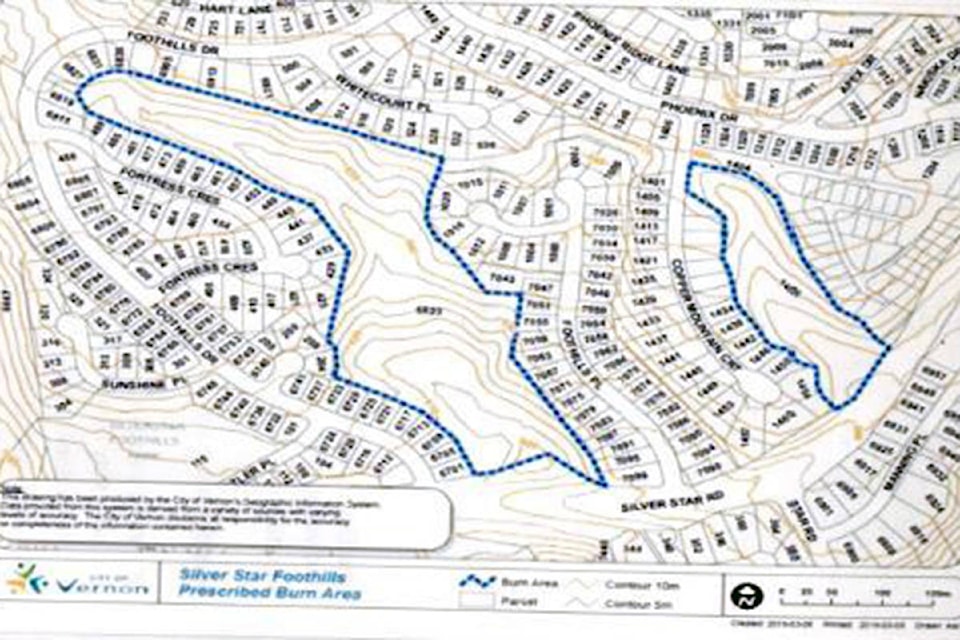Vernon Fire Rescue Services in conjunction with BX Swan Lake Fire Rescue Services, the BC Wildfire Service and professional consultants will be conducting a prescribed burn in the Foothills area with the goal of reducing the risk of wildfire by burning off fine fuels that have accumulated.
Reducing the amount of wood debris and other combustible materials in grassland and urban wildfire interface areas helps slow the spread of wildfires.
This event will take place over the course of one day, sometime between April 9 and 18, dependent on favourable conditions.
“The exact timing of this burn will depend on weather and site conditions,” said Vernon Fire Rescue Services Chief Dave Lind. “It will proceed only if conditions are suitable and will allow for quick smoke dissipation and low to moderate fire intensity.”
Firefighters will be going door to door in the Foothills area to deliver informational flyers and to answer questions. Watch for the flyer delivered to your home in the Foothills.
An information session for residents of Foothills will be held April 8, from 7 – 9 p.m. at Grace Bible Church of Vernon, 5661 Silver Star Road. Residents of Foothills who have questions are encouraged to attend the information session or call 250-542-5361 and press 1.
Safety is the number one concern and fire crews and equipment will be on scene for the burn and to mop up.
Related: Burn pile gets out of hand causing brush fire
Related: Burning season regulations to change in Central Okanagan
What is “prescribed fire?”
Prescribed fire is the planned and controlled application of fire to a specific land area and is one of the most ecologically appropriate and efficient means for achieving planned public safety and
resource management objectives.
Why is it being applied to the Foothills area?
The two parcels of City owned land in the Foothills subdivision contain grassland ecosystems that have evolved with fire. Historically fire was ignited by First Nations people as well as lightning with fires occurring very frequently. The result of frequent fire is healthy plant and animal communities. In the absence of fire, plants become less healthy and palatable to wildfire, and fuels build-up, resulting in higher severity fire than managers would like. Such fires threaten human lives and property and lead to less healthy and resilient ecosystems.
How is prescribed fire being applied?
A team of fire experts, including the Vernon Fire Rescue Services, BX Fire Rescue Services, BC Wildfire Service, and industry experts, have developed a written plan that details under what conditions of weather and fuel moisture the burn can be safely carried out that will in turn enable them to meet their ecological objectives. Other components of the plan include sections on: smoke, firefighter and public safety, communications, traffic control, and media strategy.
What are some of the ecological effects of the prescribed burn?
A low intensity fire (short flame length) will consume dead leaves, needles and grass and top-kill shrubs and small deciduous trees. To “top-kill” a plant means to kill the portion that is above the ground; most plants have the majority of their living components below ground and protected from heat. A spring burn when soil moisture is still high and soils are cool, ensures that we won’t do much damage to below-ground plant parts.
Local wildlife species will exhibit a range of actions in response to the burn. Large ungulates and predators like deer and coyotes will simply leave the area once the burn starts. Smaller mammals, amphibians and reptiles will burrow underground where they are protected from heat by moist, cold soil. Birds will also flee the area. Insects such as ticks and ground hornets are killed by the fire. In the aftermath of the fire wildlife quickly return to the area and take advantage of new, and healthier plant growth.
The Foothills burn unit contains a number of invasive weed species including wooly mullein and thistle. A low intensity fire will not have a negative or positive effect on these and other invasive species. Many of these species are highly adapted to survive disturbances such as fire. In the event of a high intensity fire that resulted in native plants being significantly damaged or killed, these species would have a competitive advantage and could occupy more of the site. A low intensity fire maintains local native plant health and vigor and an ability to outcompete non- native plants.
Related: The Smokanagan, Part two: Physical health effects
To report a typo, email:
newstips@vernonmorningstar.com.
@VernonNews
newstips@vernonmorningstar.com
Like us on Facebook and follow us on Twitter.
